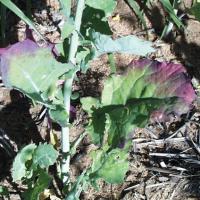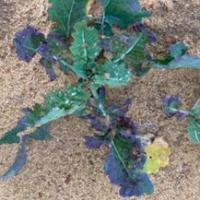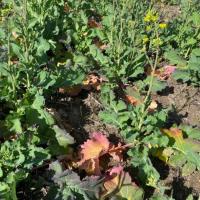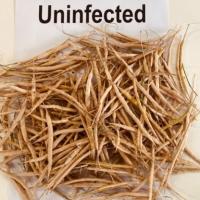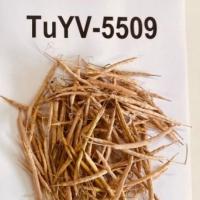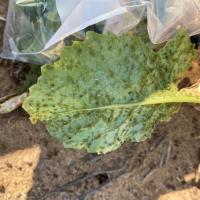Turnip yellows virus in canola: diagnosis, epidemiology and management
Turnip yellows virus (TuYV; formerly beet western yellows virus) is transmitted by the green peach aphid (Myzus persicae) and can cause yiled and quality losses in canola. It can also infect and impact other crop and pasture species including chickpea, lentil, field pea, lupin and faba bean.
What to look for
- Often TuYV infection does not produce obvious foliar symptoms, despite causing significant reductions in branch and pod numbers, and seeds per pod.
- Under certain conditions, discoloured and stunted plants can develop, initially occurring in patches located in thinner areas of the crop areas or the edge of the paddock.
Paddock
- Presence of green peach aphid in the crop is a prerequisite for TuYV spread, but often aphids can be in such low numbers per plant that they are not seen until long after after their initial incursion.
- Plants infected prior to flowering commonly produce lower seed yield often associated with fewer branches and pods. Infection can also detrimentally impact oil, glucosinolate and erucic acid content.
- If foliar symptoms develop, the first signs are red, yellow or purple colours on older leaves, particularly on the edges of leaves. Colours are more intense between leaf veins and on the upper side of the leaf. Petioles and leaf veins can be green or pale. Discoloured leaves become thickened and may cup inwards. Infected plants can be stunted and pale.
- Plants infected after flowering may show leaf symptoms but are less likely to suffer yield and quality losses.
Plant
What else could it be
| Condition | Similarities | Differences |
|---|---|---|
| Diagnosing nitrogen deficiency in canola | Purple red colours spreading down from the ends of oldest leaves | However nitrogen deficient plants are smaller and thinner rather than stunted. Paddock distribution varies according to soil type rather than in patches or edges. |
| Diagnosing Group A herbicide damage in canola | Reddish mottling of older leaves | However herbicide damage causes discolouration and distortion of emerging leaves, and multiple growing points |
| Diagnosing glyphosate damage in canola | Reddish mottling of older leaves | However herbicide damage causes discolouration and distortion of emerging leaves, and multiple growing points |
Where did it come from?

Green bridge

Insect vector
- TuYV is not seed-borne but survives in weeds or volunteer canola host plants outside the growing season and is spread from these infected plants into crops by aphids which act as vectors for virus transmission.
- Wild radish and volunteer canola are the main infection sources outside the crop, but many other broadleaf species can host the virus including common brassica and legume pasture species.
- Green peach aphid acquires TuYV from an infected plant and transmits TuYV to a healthy plant by feeding on the phloem - once acquired the aphid carries the virus for the rest of its life.
- TuYV can be found most seasons in high and medium rainfall zones but can also occur in low rainfall zones.
- Winged green peach aphid are most active in autumn and in late-winter to the end of spring when conditions are warmer. Significant TuYV spread may occur at either of these points – but autumn spread leads to more widespread early infection.
- It has a harmful impact on chickpea, lentil and field pea crops and these often become infected by proximity to infected canola crops.
Management strategies

Stubble management
- TuYV systemically infects plants and cannot be sprayed-out post-infection like a fungal disease. Therefore, control of the virus needs to be focused on prevention rather than cure.
- Control broadleaf weeds (especially volunteer canola and wild radish) at least two weeks prior to sowing - they are potential sources of TuYV.
- Use of neonicotinoid seed treatments can help reduce aphid numbers when applied effectively but cannot be solely relied upon to suppress TuYV infection.
- There are few resistant varieties available, although ATR Stingray (Nuseed) has demonstrated good resistance to a common strain of TuYV.
- Stubble retention and sowing at high seeding rates can help reduce aphid infestation and subsequent rate of TuYV spread.
- Application of newer generation insecticides such as sulfoxaflor (Transform®), afidopyropen (Versys®) and flonicamid (MainMan®) can be effective at reducing TuYV spread if timed correctly. A single application of insecticide soon after virus-carrying green peach aphid begin colonising the crop can significantly suppress TuYV spread.
- Foliar insecticide should only be considered prior to crop flowering when the crop is vulnerable to TuYV-induced yield losses. Green peach aphid feeding damage is rare and only occurs when extremely large populations develop on plants.
- DPIRD may be doing green peach aphid and TuYV surveillance in your region so keep an eye on PestFacts WA for alerts that may help inform a foliar insecticide decision.
- PLEASE NOTE: Pirimicarb, organophosphate and synthetic pyrethroid insecticides are likely ineffective against green peach aphids because of widespread resistance.
See also
Where to go for expert help
Page last updated: Tuesday, 26 March 2024 - 8:04am


